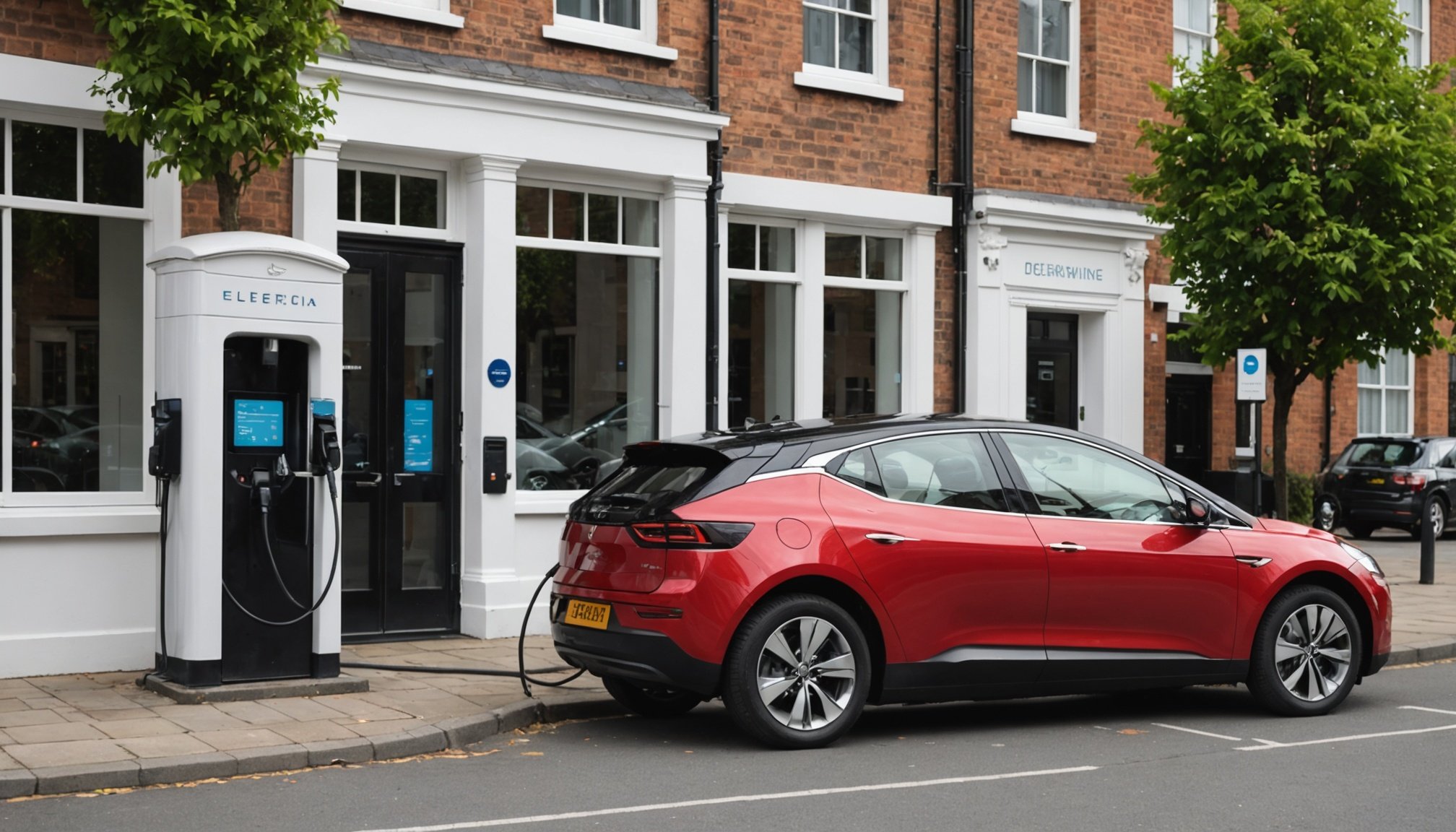Unlocking the Full Potential of Your Electric Vehicle: A Guide to Navigating the UK’s Growing EV Charging Network
As the UK continues to embrace the transition to electric vehicles (EVs), the infrastructure to support this shift is expanding rapidly. With over 1.3 million EVs now on UK roads and making up 19% of all new cars sold in 2024, understanding the public charging network is crucial for any EV owner. Here’s a comprehensive guide to help you navigate the UK’s evolving EV charging landscape.
Understanding the UK’s EV Charging Infrastructure
The UK’s public EV charging network has seen significant growth in recent years. As of the end of December 2024, there are 36,316 charging locations with 72,594 EV charging points and 106,094 connectors across the country[1][2][4].
Also read : Understanding the dangers: how illegal vehicle modifications affect uk drivers
Types of Charging Points
The charging points in the UK can be categorized based on their connectors and charging speeds:
- Type 2 Connectors: These are the most common and can be found at most public charging stations. There are over 70,000 Type 2 connectors available[1].
- CCS (Combined Charging System) Connectors: These support faster charging and there are approximately 15,000 CCS connectors[1].
- CHAdeMO Connectors: Primarily used by older EV models, there are around 8,600 CHAdeMO connectors[1].
Rapid and Ultra-Rapid Chargers
For those needing a quick top-up, rapid and ultra-rapid chargers are becoming increasingly prevalent. There are 25,361 rapid/ultra-rapid connectors spread across 5,821 locations, with 510 rapid charging hubs offering at least six charging points each[1].
Also to read : Ultimate all-weather tires for navigating the uk”s ever-changing climate
Where to Find EV Chargers in the UK
The distribution of EV chargers varies significantly across different regions in the UK.
Regional Breakdown
- Greater London: Leads with the highest number of charging points, boasting 21,488 chargers within the capital[1].
- South East: Follows with 9,290 charging points[1].
- West Midlands: Ranks third with 7,156 points[1].
- Scotland: Has 6,015 charging points[1].
- Northern Ireland: Trails behind with only 651 charging points[1].
Key Charging Networks
Several companies are at the forefront of providing comprehensive charging networks:
Gridserve
- Known for its Electric Forecourts, Gridserve offers a unique charging experience with amenities like food, drink, and shopping areas. They have over 190 locations with 1,500 charging points, and three operational Electric Forecourts at Braintree, Norwich, and Gatwick Airport[1].
- Pricing: Fast chargers cost £0.49, while rapid and ultra-rapid chargers cost £0.79[1].
Pod Point
- One of the oldest and most extensive networks, Pod Point has over 5,000 locations with more than 9,000 charging points. Many of these are found in Tesco and Lidl car parks[1][5].
- Pricing: Rates vary from £0.44 to £0.69 for fast and rapid chargers, respectively[1].
InstaVolt
- InstaVolt is the UK’s largest owner-operator of rapid DC charging points. They have over 1,800 chargers and plan to install 10,000 more by 2032. Charging costs £0.85 during peak hours and £0.54 during off-peak hours[1].
- Ease of Use: Known for its pay-as-you-go model using contactless cards or the app[1].
How to Charge Your Electric Vehicle
Charging your EV is becoming increasingly straightforward, thanks to the various payment methods and user-friendly interfaces offered by charging networks.
Using Public Charging Stations
Here’s a step-by-step guide to using public charging stations:
- Finding a Charger: Use apps like ZapMap or the network’s own app to locate charging points along your route[1][2][5].
- Initiating the Charge: Most networks offer contactless payment or require you to use their app to start the charging process. For example, Gridserve and InstaVolt allow contactless payments, while Pod Point requires you to find the charge point name and initiate the charge through their app[1][5].
- Monitoring the Charge: Many networks provide real-time updates on the charging status through their apps.
Cost-Effective Charging
Understanding the pricing models of different charging networks can help you save money.
Pricing Models
Here is a comparison of the pricing models of some major charging networks:
| Network | Fast Charging Rate | Rapid/Ultra-Rapid Charging Rate |
|---|---|---|
| Gridserve | £0.49 | £0.79 |
| Pod Point | £0.44 – £0.49 | £0.62 – £0.69 |
| InstaVolt | £0.85 (peak), £0.54 (off-peak) | £0.85 (peak), £0.54 (off-peak) |
| ESB Energy | £0.40 (PAYG), £0.38 (membership) | £0.55 (PAYG), £0.42 (membership) |
| char.gy | 42p/kWh (PAYG), 15p/kWh (membership) | N/A |
Membership and Subscription Benefits
Some networks offer membership or subscription plans that can reduce your charging costs:
- Pod Point: Offers a free subscription with rates starting from 28p/kWh for standard charging[5].
- InstaVolt: Does not have a subscription model but offers lower rates during off-peak hours[1].
- char.gy: Provides a monthly membership for £38.99, including 200kWh of charging at 15p/kWh after the allowance is used up[3].
User Satisfaction and Feedback
Despite the growth in charging infrastructure, user satisfaction is an important metric to consider.
User Surveys and Feedback
A survey by ZapMap revealed some interesting insights:
- Satisfaction Rate: 87% of EV owners are satisfied with their vehicles, citing cost-effectiveness, environmental factors, and vehicle performance as key reasons[2].
- Public Charging Satisfaction: However, the satisfaction rate for public charging points is lower at 64%. This highlights the need for continued improvement in the charging network[2].
- Improvement in Charging Network: 61% of EV owners noted an improvement in the charging network in 2024, up from 38% in the previous year[2].
Future Developments and Government Support
The UK government is actively supporting the expansion of the EV charging infrastructure.
Government Initiatives
- Local EV Infrastructure Fund: Plans to install another 100,000 chargers across England, supported by £6 billion of private investment by 2030[4].
- Daily Additions: On average, 56 public chargers are added to the network every day in 2024[4].
- Energy Secretary Ed Miliband: Emphasized the importance of accelerating the transition to electric vehicles, highlighting its role in the UK’s clean energy mission and economic opportunities[4].
Practical Tips for EV Owners
Here are some practical tips to help you make the most of the UK’s EV charging network:
Plan Your Route
- Use apps like ZapMap to find charging points along your route, ensuring you never run out of charge.
Choose the Right Network
- Select a charging network that aligns with your needs, whether it’s based on pricing, convenience, or speed.
Home Charging
- If possible, install a home charging point to reduce your reliance on public charging and save money.
Keep Your Battery Healthy
- Avoid letting your battery drop to very low levels regularly, as this can affect its longevity.
Navigating the UK’s EV charging network is becoming increasingly straightforward as the infrastructure continues to expand and improve. By understanding the different types of charging points, pricing models, and user feedback, you can unlock the full potential of your electric vehicle. Whether you’re a seasoned EV owner or just starting your electric journey, the UK’s growing charging network is here to support you every step of the way.
Additional Resources
For those looking to delve deeper into the world of EV charging, here are some additional resources:
- ZapMap App: A comprehensive app for finding and using public charging points across the UK[2].
- Government Guidelines: The UK government’s official resources on EV charging infrastructure and initiatives[4].
- Charging Network Websites: Websites of major charging networks like Gridserve, Pod Point, and InstaVolt provide detailed information on their services and pricing[1][5].
By leveraging these resources and staying informed, you can ensure a seamless and cost-effective EV charging experience.











